 Above is a shot of Bee Orchids growing amongst the Ox Eye Daisies, on an unmowed hillside block in Roux. This place is hidden from view from the track that runs along the bottom, but my mother and I happened to meet the owner walking his aged spaniel as we were photographing Bee Orchids and some unusually tall Man Orchids on the trackside bank. He very kindly invited us to go up into the field and we were delighted with what we found.
Above is a shot of Bee Orchids growing amongst the Ox Eye Daisies, on an unmowed hillside block in Roux. This place is hidden from view from the track that runs along the bottom, but my mother and I happened to meet the owner walking his aged spaniel as we were photographing Bee Orchids and some unusually tall Man Orchids on the trackside bank. He very kindly invited us to go up into the field and we were delighted with what we found.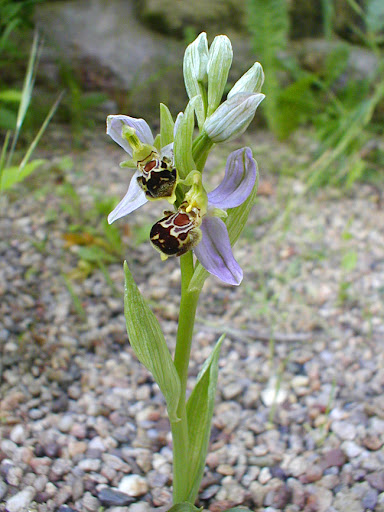 Actually, we didn't even need to go as far as the field on the hill to see Bee Orchids. This one was happily flowering in the gravelled garden of the gîte we were staying in. Notice that the upper flower is a mutation, looking rather like the form known as a Wasp Orchid. It is not uncommon for the form of the flowers on a single stem to vary like this.
Actually, we didn't even need to go as far as the field on the hill to see Bee Orchids. This one was happily flowering in the gravelled garden of the gîte we were staying in. Notice that the upper flower is a mutation, looking rather like the form known as a Wasp Orchid. It is not uncommon for the form of the flowers on a single stem to vary like this.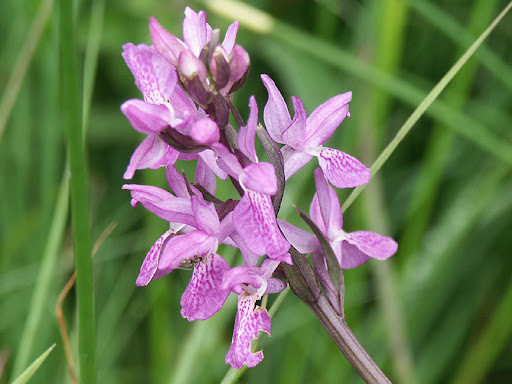 Here is one of the Brenne Orchids. They are one of the dreaded Dactylorhiza genus, which are notoriously difficult to separate from one another, and often several species grow in close proximity and reputedly hybridise like mad with each other, with the result that it is often very difficult to know which species you have (although Quentin Groom tells me that they hybridise far less than is generally believed, but are extremely variable within species). Where we found these, we also found their close cousins the Common Spotted Orchid. The Brenne Orchid is even more closely related to the Robust Marsh Orchid, and until 20 years ago, was considered to just be a subspecies, so as you can imagine, they look very, very similar. I think I have the hang of separating them now though - the bracts (leaflets that sit behind each individual flower) are very long in the Robust Marsh Orchid and poke out quite noticeably from amongst the flowers, whereas the Brenne Orchids' bracts are shorter and more hidden in the flower spike.
Here is one of the Brenne Orchids. They are one of the dreaded Dactylorhiza genus, which are notoriously difficult to separate from one another, and often several species grow in close proximity and reputedly hybridise like mad with each other, with the result that it is often very difficult to know which species you have (although Quentin Groom tells me that they hybridise far less than is generally believed, but are extremely variable within species). Where we found these, we also found their close cousins the Common Spotted Orchid. The Brenne Orchid is even more closely related to the Robust Marsh Orchid, and until 20 years ago, was considered to just be a subspecies, so as you can imagine, they look very, very similar. I think I have the hang of separating them now though - the bracts (leaflets that sit behind each individual flower) are very long in the Robust Marsh Orchid and poke out quite noticeably from amongst the flowers, whereas the Brenne Orchids' bracts are shorter and more hidden in the flower spike.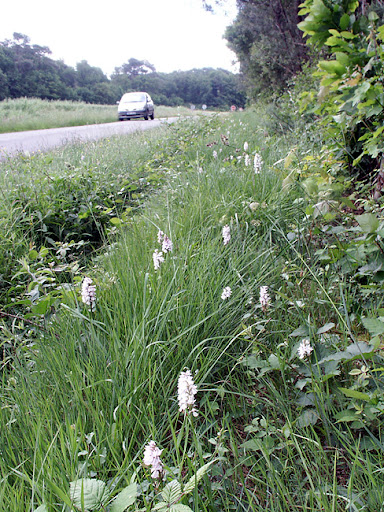 More Dactylorhiza above - this time Heath Spotted Orchids on the roadside near Boussay.
More Dactylorhiza above - this time Heath Spotted Orchids on the roadside near Boussay.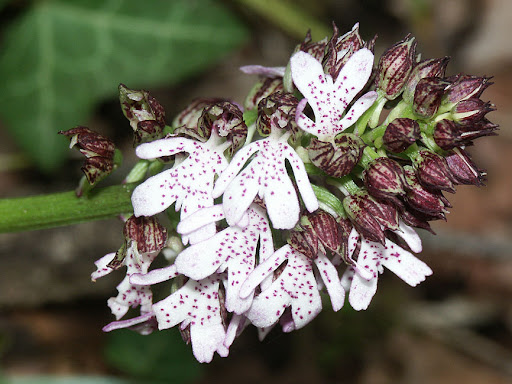 I've now managed to sort out my confusion with the ladies, the soldiers and the monkeys, who also potentially hybridise like mad. The above is a Lady Orchid, and below a Military Orchid. Interestingly, it seems we get the ladies on one side of the river at Chaumussay, and the soldiers on the other.
I've now managed to sort out my confusion with the ladies, the soldiers and the monkeys, who also potentially hybridise like mad. The above is a Lady Orchid, and below a Military Orchid. Interestingly, it seems we get the ladies on one side of the river at Chaumussay, and the soldiers on the other.
 The Monkeys just swarm about everywhere.
The Monkeys just swarm about everywhere. Here I am demonstrating just how big the Lizard Orchids around Preuilly can get. The tallest reaches my elbow, but they are such an ethereal collection of silvery pink streamers they are surprisingly difficult to photograph well. Strange that something that looks like it should inhabit a fairyland emits a pong on a hot day that I could describe to you exactly, but in the interests of polite society, will not. Suffice to say that regular use of a bidet would help.
Here I am demonstrating just how big the Lizard Orchids around Preuilly can get. The tallest reaches my elbow, but they are such an ethereal collection of silvery pink streamers they are surprisingly difficult to photograph well. Strange that something that looks like it should inhabit a fairyland emits a pong on a hot day that I could describe to you exactly, but in the interests of polite society, will not. Suffice to say that regular use of a bidet would help.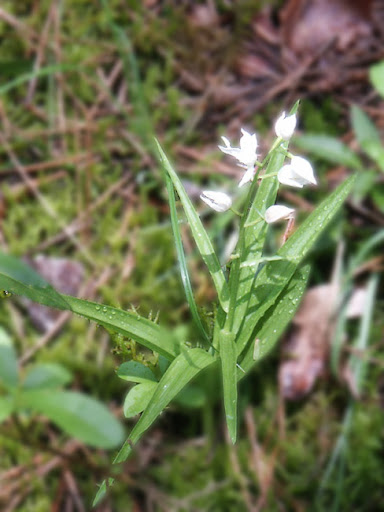 In some cases we were able to find the very same plants that we saw last year, for example, a Man Orchid on the roadside just outside Bossay sur Claise, and this Helleborine (above). Last year there was some discussion on the blog about the precise identity of this plant from some experienced orchidophiles, but I am sticking to my guns that this is the Narrow-leafed Helleborine. It has no visible bracts; the leaves are narrow and the upper ones longer than the flower spike; the flowers are very white and reveal a yellow blotch at the base of the inside of the lower petal. Its rival, the White Helleborine would have bracts that are longer than the flowers; shorter, wider leaves and creamy flowers with an orangey yellow blotch.
In some cases we were able to find the very same plants that we saw last year, for example, a Man Orchid on the roadside just outside Bossay sur Claise, and this Helleborine (above). Last year there was some discussion on the blog about the precise identity of this plant from some experienced orchidophiles, but I am sticking to my guns that this is the Narrow-leafed Helleborine. It has no visible bracts; the leaves are narrow and the upper ones longer than the flower spike; the flowers are very white and reveal a yellow blotch at the base of the inside of the lower petal. Its rival, the White Helleborine would have bracts that are longer than the flowers; shorter, wider leaves and creamy flowers with an orangey yellow blotch. This gorgeous colour palette is Early Purple Orchids and Cowslips on the roadside near Humeau.
This gorgeous colour palette is Early Purple Orchids and Cowslips on the roadside near Humeau. And yet another Dactylorhiza. This one's a bit of a ring in - it was photographed next to a German forward observation post on the cliffs at Longues sur Mer, overlooking one of the World War II D-Day (Operation Overlord) landing beaches. In fact, this photograph was taken on the 64th anniversary of the Landings. It is a Common Spotted Orchid, which we also saw in the Brenne, but they are much more common in the departément of Calvados (where this one is), far to the north of us.
And yet another Dactylorhiza. This one's a bit of a ring in - it was photographed next to a German forward observation post on the cliffs at Longues sur Mer, overlooking one of the World War II D-Day (Operation Overlord) landing beaches. In fact, this photograph was taken on the 64th anniversary of the Landings. It is a Common Spotted Orchid, which we also saw in the Brenne, but they are much more common in the departément of Calvados (where this one is), far to the north of us.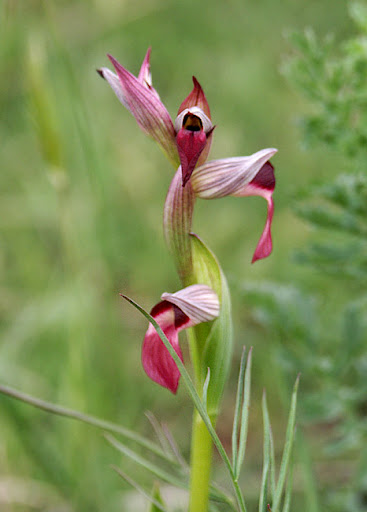 This is a Tongue Orchid, one of the specialities of the Brenne. They like damp grassland and are what is referred to as a locally common species; i.e. they don't occur in many places, but where they do, you have to be careful where you put your feet because there will be so many of them you are bound to step on them.
This is a Tongue Orchid, one of the specialities of the Brenne. They like damp grassland and are what is referred to as a locally common species; i.e. they don't occur in many places, but where they do, you have to be careful where you put your feet because there will be so many of them you are bound to step on them. This Violet Limodore is one of two parasitic orchids we came across. The other is the Bird's Nest Orchid. This one above was growing right in the middle of the path on the hillside behind Chaumussay. We visited it every few days so that we could make sure we got good photos once it opened. Very sadly, we never got those shots of it in its glory days. One day we visited, and found that someone had cut it off close to ground level. I cannot tell you how shocked I was. It appeared to be a deliberate, but pointless act. The stem had clearly been severed with a blade, and the flower bud just discarded on the path. This plant is totally protected in the region of Centre, so to cut it off like this is illegal.
This Violet Limodore is one of two parasitic orchids we came across. The other is the Bird's Nest Orchid. This one above was growing right in the middle of the path on the hillside behind Chaumussay. We visited it every few days so that we could make sure we got good photos once it opened. Very sadly, we never got those shots of it in its glory days. One day we visited, and found that someone had cut it off close to ground level. I cannot tell you how shocked I was. It appeared to be a deliberate, but pointless act. The stem had clearly been severed with a blade, and the flower bud just discarded on the path. This plant is totally protected in the region of Centre, so to cut it off like this is illegal.Susan
(Note that all the links to photographs illustrating species were taken by us unless I have obviously linked to a website to provide further information.)
[This post has been edited as both Prof Richard Bateman and Quentin Groom thought the Longues sur Mer orchid was Dactylorhiza fuchsii, not D praetermissa. I am certainly not going to argue with Prof Bateman, who is a world expert from Kew and whose name appears as the first to describe more than one species of orchid in my field guides. Quentin Groom is the BSBI European species beginners referee for photographs, which means his knowledge is also very extensive. I am very grateful to both of them for taking the time to look at my photos, especially Prof Bateman, who was extremely busy at the time with some urgent research work. He joked that maybe the orchid seeds had come across on a squaddie's boot. I would also like to thank Quentin for his interesting and helpful comments regarding the identification and biology of Dactylorhiza spp.]
For more on orchids, please click here

3 comments:
Marvelous! I like orchids but I do not now the french species, this post helps me a lot to see the differences and also the species to look for :) But I never cut them, I know they're protected and I just take the photos. Thank you for this very nice post.
A fabulous post. If plant lovers know of your blog, it could produce some tourist enthusiasts for South Touraine & Preuilly next year. Now if you could get them all to flower together, you could run Orchid tours.
Congratulations to the sage and the photographer.
Jill & John
Great photos, very interesting post,and very kind of the gentleman to invite you!!
Post a Comment